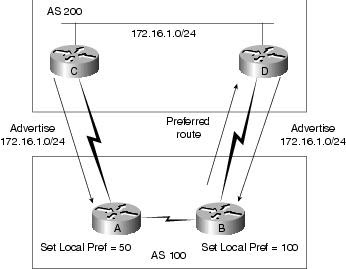BGP Attributes
BGP best-path algorithm:
We Love Oranges AS Oranges Mean Pure Refreshment
This translates to:
Weight, Local Pref, Originate, AS_Path, Origin, MED, Paths, RouterID

Local Preference Attribute
The local preference attribute is used to prefer an exit point from the local autonomous system (AS). Unlike the weight attribute, the local preference attribute is propagated throughout the local AS. If there are multiple exit points from the AS, the local preference attribute is used to select the exit point for a specific route.
Local Pref is only ever advertised between iBGP peers.
The default value for local preference is 100.

But when take a look closer, we can see both path have default value 100.
R3>sh ip bgp 192.168.12.0/24
BGP routing table entry for 192.168.12.0/24, version 19
Paths: (2 available, best #2, table Default-IP-Routing-Table, not advertised to EBGP peer) Advertised to update-groups: 2 3
200 4.4.4.4 (metric 2) from 4.4.4.4 (4.4.4.4)
Origin IGP, metric 0, localpref 100, valid, internal
Community: no-export
100 172.16.13.1 from 172.16.13.1 (192.168.100.1)
Origin IGP, metric 0, localpref 100, valid, external, best
Community: no-export
R3>

Weight Attribute
Weight is a Cisco-defined attribute that is local to a router. The weight attribute is not advertised to neighboring routers. If the router learns about more than one route to the same destination, the route with the highest weight will be preferred.
From previous show ip bgp output on R3, we notice that for local generated bgp route, it automatically gives a weight value 32768.
http://www.cisco.com/en/US/docs/internetworking/technology/handbook/bgp.html
The default value for local preference is 100.
 with default local preference, let's take a look the output from R3, we can see R3 receives the route of 192.168.12.0/24 from two paths, the interesting thing is that the path from 172.16.13.1 which is R1 has no Local Preference value displayed, the route from R4 (4.4.4.4) does have default Local Preference value 100.
with default local preference, let's take a look the output from R3, we can see R3 receives the route of 192.168.12.0/24 from two paths, the interesting thing is that the path from 172.16.13.1 which is R1 has no Local Preference value displayed, the route from R4 (4.4.4.4) does have default Local Preference value 100.

But when take a look closer, we can see both path have default value 100.
R3>sh ip bgp 192.168.12.0/24
BGP routing table entry for 192.168.12.0/24, version 19
Paths: (2 available, best #2, table Default-IP-Routing-Table, not advertised to EBGP peer) Advertised to update-groups: 2 3
200 4.4.4.4 (metric 2) from 4.4.4.4 (4.4.4.4)
Origin IGP, metric 0, localpref 100, valid, internal
Community: no-export
100 172.16.13.1 from 172.16.13.1 (192.168.100.1)
Origin IGP, metric 0, localpref 100, valid, external, best
Community: no-export
R3>

Weight Attribute
Weight is a Cisco-defined attribute that is local to a router. The weight attribute is not advertised to neighboring routers. If the router learns about more than one route to the same destination, the route with the highest weight will be preferred.
From previous show ip bgp output on R3, we notice that for local generated bgp route, it automatically gives a weight value 32768.
http://www.cisco.com/en/US/docs/internetworking/technology/handbook/bgp.html
MED (Multiple Exit discriminator) – This path attribute uses a metric as well. MED is typically used by an AS that is multi-homed to instruct an external AS (that it is peered with) that it has a preferred entry point for a particular network address block. This can be used for inbound tuning – lower metric values are preferred.
With two connections to AWS, AWS set MED to specify which connection is the primary
Comments
Post a Comment